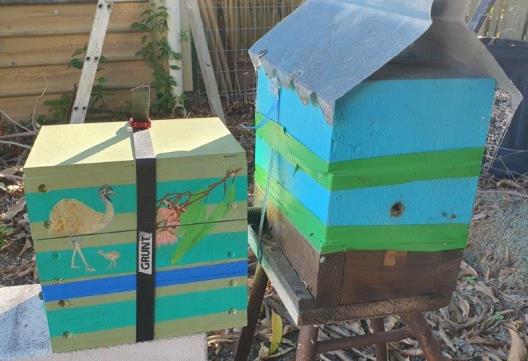Welcome to 2023 and looking for and exciting year ahead. Like most, I guess my bees have taken a bit of a back seat over the past few weeks with Xmas and for me turtle nesting has been in full swing and continues with hatchlings now due out and I will be spending some time closer to home this time over on Facing Island. After 3 weeks on Wild Duck Island for the nesting census, I have been able to at least attend to a few of my hives and they appear to have responded to the warmer weather accordingly. First job when back was to check on the two donated hives at both Tannum Kindy and Boyne Island School and I am pleased to say they are doing extremely well and I feel sure the kids will get much pleasure from them in the New Year. Both the mother hives have now been relocated back home, leaving the daughter hives to strengthen. I was very pleased to see the artwork the kids did for me in my absence and both hives now have pride of place in my garden.
I have not heard from GRC this water meter reading peri-od of any hives in need of rescuing however one residential unit complex in Gladstone did contact me directly reporting three meter boxes with bees and would like them rescued. When I checked these just before Christ-mas, I found only one to be active and it was very successfully rescued. This hive seemed a lot stronger than most meter rescues but as an added precaution, I connected it up to a host eduction hive for just 1 week be-fore disconnecting and there has been an incredible amount of work done by the extra resources. This hive will be transferred to its new home soon all going well as a belated Christmas gift.
Just before going on my Turtle trip I received a copy of “Keeping Australian Native Bees” by Greg Coonan and found it a very practical guide to in particular rescuing bees with some very good tips. I applied some of this information to my last two water meter rescues and have to say it has worked. The first one just before I went away was a very weak hive and rather than have it succumb to phorid fly invasion, I closed it up for 4 weeks giving the occupants time to get their defences inside organized before releasing them to their new environ-ment. Whilst still low on numbers, they seem to be surviving quite well and I will be monitoring it closely
My next effort was my first attempt at splitting an AA hive and whilst I did need to do a horizontal cut to dis-tribute the brood equally, early indications are that it has been very successful. This was a log rescue which I had in its original log for two years before having to put it into a mini OATH hive just over two years ago. Once split, the occupants immediately commenced building an external defence tube and only three days later, I observed swarming around both mother and daughter plus two nearby AA log hives as well. Interestingly the swarming only lasted for about 15 minutes and everything seemed to settle down on all four hives. I have been getting much enjoyment over the last couple of days sitting out there in the afternoon with a glass of wine and seeing them successfully turn away the odd phorid fly that attempts to get past the guards. Nothing like bush TV.
Some interesting feedback from other members included quite a bit of discussion and concern around the presence of Cadaghi seeds being collected by foraging bees and in fact I have observed some of my own hives doing the same. One of our members has resorted to installing a kitchen scrubbing brush at the entrance to help the bees remove the seeds. Guess that’s like installing a door mat to clean your feet before entering. I have also seen the use of coconut fibre.
A friend has just moved house and relocated her bees to the new property. She was initially concerned about the process but has reported that the move went well and they have settled in very comfortably. Her main concern when moving them was than when she placed them in the vehicle, there was a very strong odour in the car of marijuana, and she was worried if the police pulled her up along the way they may detect it. It seems the odour has now gone soon after being relocated. Just wondering if it may have been what they were foraging on in the old location and if anyone else has had this experience?
From Secretary Ian Anderson and Chairman Mark Larney
For more info on branch activities, visit our Facebook page ANBA Gladstone Branch, https://www.facebook.com/groups/480678232538075


